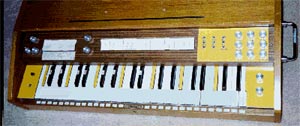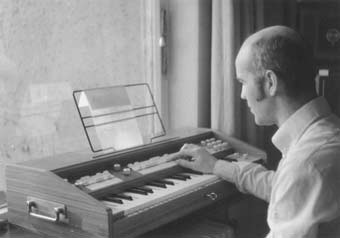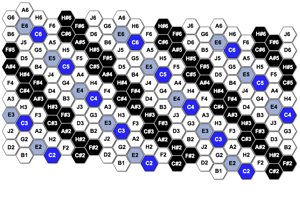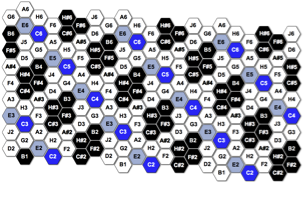Prior Research
Bohlen-Pierce Scale Research Paper, 2001 (pdf) - I wrote this research paper for an Advanced Acoustics class at New York University in the Spring of 2001 while obtaining my masters degree in Music Technology. I graduated in 2001. It included listening tests with nine widely varied subjects.






Heinz Bohlen’s homemade BP Scale keyboard built in 1972 (above).
Heinz in 1973, tinkering with the transcription of a Christmas carol into his 13-Step Scale (right).



John Robinson Pierce, 1910 - 2002
(Picture courtesy of CCRMA, Stanford, CA)
(Picture courtesy of CCRMA, Stanford, CA)
Heinz Bohlen at Stanford, 2001
(Picture by Elaine Walker)
(Picture by Elaine Walker)

The story of the Bohlen-Pierce Scale and it’s inventors is a bittersweet one. Sadly, the two microwave engineers who invented the Scale independently six years apart, never met even though they both lived in the San Francisco area for a number of years. When John Pierce passed away in 2002, Heinz's dream of meeting him and discussing their co-invented scale in person, died with him. Heinz was also a fan of John Pierce because of his fame in the microwave engineering world. John Pierce is credited for inventing the idea of the communication satellite. In turn, John Pierce may have been envious that Heinz Bohlen invented the BP Scale six years before he did.
It all started in the early 1970s when Heinz Bohlen became curious as to why musicians always use the same 12 note per octave tuning. After getting some unsatisfactory answers from musicians, he took it upon himself to research music and tonality. It was finally the understanding of combination tones that lead him to believe he could use the same method that lead to the 12 tone equal temperament, to devise another tuning from a different framework. He understood that the 12 tone scale was based around the a major triad, the inversion, and then filling in the gaps. So, he started with a new triad that was very harmonically pure, but not contained within the normal 12 tone framework. He made the stunning discovery that a scale of thirteen almost equal steps within the framework of an octave and a fifth (which John Pierce later dubbed as a tritave) contained this very pure triad. He recognized that this tuning shared a duality with the traditional Western 12 tone tuning, it had harmonic value, and that it would be a valid compositional tool.
Amazingly, during the same time frame, another man named Kees van Prooijen had independently invented the BP Scale during his research in generic equal temperaments. But even more amazingly, a second microwave engineer named John R. Pierce made the same discovery, six years later. He arrived at the tuning using a different method, but for the same reason - Curiosity. Leave it to microwave engineers to invent a tuning with no octaves! When John Pierce realized it had already been invented by Heinz Bohlen, the tuning was dubbed the “Bohlen-Pierce Scale. He was apparently unaware of Kees van Proojijen. Coincidentally, John Pierce wrote “The Science of Musical Sound”, which was my favorite childhood coffee table book. When my professor at Berklee College of Music, Dr. Boulanger, introduced me to the BP Scale in 1991, I knew the name John R. Pierce sounded familiar. That XMas I found the book in my parents living room and remembered how I loved the book when I was younger.
I had the pleasure of meeting Heinz Bohlen in 2001 in San Jose where he lived when I was on a trip to visit Stanford. We both ventured to Stanford looking for Max Mathews (the “Father of computer music”), but he was not there that week. We had hopes of having a grand reunion of Max Mathews, John Pierce, Heinz Bohlen, and myself. Dr. Richard Boulanger has also worked extensively with Max Mathews and John Pierce on Bohlen-Pierce Scale music and research. He informed me that John Pierce was in the hospital with Alzheimer's and was not taking visitors. Alas, the reunion never happened, but I found Heinz Bohlen to be delightful company over sushi. He took a great interest in my Chaos Melody Theory research and we talked about chaos theory more than the BP Scale! Heinz and I have kept in touch and remained friends ever since. - EW


I proposed this "piano" layout as part of my thesis. It references Lambda mode. Heinz agrees that Lambda may be the best reference mode. Nothing is set in stone yet, but things are strongly leaning towards Lambda.
Current Research
In 2007 I learned of a new controller called the AXIS by C-Thru Music. They kindly lent an AXIS to me for several months. It was the first prototype AXIS that the Lionel Richie band had before me. The diagram on the top shows the original layout of the harmonic table for the 12 tone tuning. Notice that the black keys reference the black keys on a normal piano keyboard.
I tediously explored a few different layouts for the Bohlen-Pierce Scale by rearranging the key colors. I also mapped out chords and tried different ways of playing the modes and eventually settled on the layout shown on the bottom, right.
I took the AXIS to Berklee College of Music in March, 2008, demo'ed it for the BP Scale to Dr. Boulanger's classes, and let them keep it per my agreement with C-Thru Music. I miss it terribly! I later learned of another company called The Shape of Music who build a similar device called the Sonome. The inventor of the harmonic table, Peter Davies, owns this company.
A harmonic table works well for the Bohlen-Pierce Scale for a number of reasons. Due to the nature of the Bohlen-Pierce Scale, it is often necessary to make giant leaps across the keyboard or use chords with a very wide stretch. This layout makes it easier to access far-stretching intervals with one hand. A large interval going to a small interval is often just a matter of rotating your hand position.
The Circlular Keyboard is one that I hope to have built, which allows the hexagons to be turned 90 (or 30) degrees. I'm currently raising money for this project!
I am working out layouts for other microtunings and macrotunings. The midi-note-number mappings for each tuning will be presets on the instrument, and the key colors will either need to be rearranged by hand, or will be backlit as part of the presets.
Goals
My ultimate goal is to help develop an instrument that is not only compatible, but OPTIMAL for playing a wide variety of micro and macro tunings. If anyone reading this is interested and has a specific tuning in mind, please let me know. I am only familiar with BP, 19tet and 10tet and have rarely used any others, so I will need input. My immediate goal is to work out key layouts, so that any AXIS or Sonome user can easily perform with different tunings.



Heinz and Elaine at Stanford, 2001
The Bohlen-Pierce Scale
-Elaine Walker

The two inventors of the Bohlen-Pierce Scale



This was my favorite childhood "coffee table" book. It's a coincidence. No joke!


Rearranged key colors for BP Scale (Lambda Mode)

Rearranged key colors for BP Scale(Dur II Mode)



Original layout for 12 tone tuning
